Class 9 Maths Chapter 6 Question Answers - Lines & Angles
Q1: In the figure, lines AB and CD intersect at O. If ∠AOC + ∠BOE = 70° and ∠BOD = 40°, find ∠BOE and reflex ∠COE.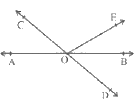 Sol:
Sol:
From the given figure, we can see;
∠AOC, ∠BOE, ∠COE and ∠COE, ∠BOD, ∠BOE form a straight line each.
So, ∠AOC + ∠BOE +∠COE = ∠COE +∠BOD + ∠BOE = 180°
Now, by substituting the values of ∠AOC + ∠BOE = 70° and ∠BOD = 40° we get:
70° +∠COE = 180°
∠COE = 110°
Similarly,
110° + 40° + ∠BOE = 180°
∠BOE = 30°
Q2: In the Figure, POQ is a line. Ray OR is perpendicular to line PQ. OS is another ray lying between rays OP and OR. Prove that ∠ROS = 1/2(∠QOS – ∠POS). Sol:
Sol:
In the question, it is given that (OR ⊥ PQ) and ∠POQ = 180°
So, ∠POS + ∠ROS + ∠ROQ = 180° (Linear pair of angles)
Now, ∠POS + ∠ROS = 180° – 90° (Since ∠POR = ∠ROQ = 90°)
∴ ∠POS + ∠ROS = 90°
Now, ∠QOS = ∠ROQ + ∠ROS
It is given that ∠ROQ = 90°,
∴ ∠QOS = 90° + ∠ROS
Or, ∠QOS – ∠ROS = 90°
As ∠POS + ∠ROS = 90° and ∠QOS – ∠ROS = 90°, we get
∠POS + ∠ROS = ∠QOS – ∠ROS
⇒ 2 ∠ROS + ∠POS = ∠QOS
Or, ∠ROS = ½ (∠QOS – ∠POS) (Hence proved).
Q3: In the Figure, if AB || CD, EF ⊥ CD and ∠GED = 126°, find ∠AGE, ∠GEF and ∠FGE. Sol:
Sol:
Since AB || CD GE is a transversal.
It is given that ∠GED = 126°
So, ∠GED = ∠AGE = 126° (alternate interior angles)
Also,
∠GED = ∠GEF + ∠FED
As
EF ⊥ CD, ∠FED = 90°
∴ ∠GED = ∠GEF + 90°
Or, ∠GEF = 126° – 90° = 36°
Again, ∠FGE + ∠GED = 180° (Transversal)
Substituting the value of ∠GED = 126° we get,
∠FGE = 54°
So,
∠AGE = 126°
∠GEF = 36° and
∠FGE = 54°
Q4: In Fig. 6.33, PQ and RS are two mirrors placed parallel to each other. An incident ray AB strikes the mirror PQ at B, the reflected ray moves along the path BC and strikes the mirror RS at C and again reflects back along CD. Prove that AB || CD.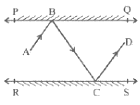 Sol:
Sol:
First, draw two lines BE and CF such that BE ⊥ PQ and CF ⊥ RS.
Now, since PQ || RS,
So, BE || CF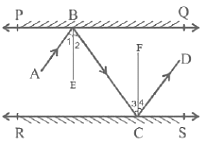 BE and CF are normals between the incident ray and reflected ray.As we know,
BE and CF are normals between the incident ray and reflected ray.As we know,
Angle of incidence = Angle of reflection (By the law of reflection)
So,
∠1 = ∠2 and
∠3 = ∠4
We also know that alternate interior angles are equal.
Here, BE ⊥ CF and the transversal line BC cuts them at B and C.
So, ∠2 = ∠3 (As they are alternate interior angles)
Now, ∠1 + ∠2 = ∠3 + ∠4
Or, ∠ABC = ∠DCB
So, AB ∥ CD (alternate interior angles are equal)
Q5: In the figure, if AB || CD || EF, PQ || RS, ∠RQD = 25° and ∠CQP = 60°, then find ∠QRS. Sol: According to the given figure, we have
Sol: According to the given figure, we have
AB || CD || EF
PQ || RS
∠RQD = 25°
∠CQP = 60°
PQ || RS.
As we know,
If a transversal intersects two parallel lines, then each pair of alternate exterior angles is equal.
Now, since, PQ || RS
⇒ ∠PQC = ∠BRS
We have ∠PQC = 60°
⇒ ∠BRS = 60° … eq.(i)
We also know that,
If a transversal intersects two parallel lines, then each pair of alternate interior angles is equal.
Now again, since, AB || CD
⇒ ∠DQR = ∠QRA
We have ∠DQR = 25°
⇒ ∠QRA = 25° … eq.(ii)
Using linear pair axiom,
We get,
∠ARS + ∠BRS = 180°
⇒ ∠ARS = 180° – ∠BRS
⇒ ∠ARS = 180° – 60° (From (i), ∠BRS = 60°)
⇒ ∠ARS = 120° … eq.(iii)
Now, ∠QRS = ∠QRA + ∠ARS
From equations (ii) and (iii), we have,
∠QRA = 25° and ∠ARS = 120°
Hence, the above equation can be written as:
∠QRS = 25° + 120°
⇒ ∠QRS = 145°
Q6: In the Figure, lines XY and MN intersect at O. If ∠POY = 90° and a : b = 2 : 3, find c.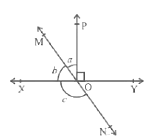 Sol: As we know, the sum of the linear pair is always equal to 180°
Sol: As we know, the sum of the linear pair is always equal to 180°
So,
∠POY + a + b = 180°
Substituting the value of ∠POY = 90° (as given in the question) we get,
a + b = 90°
Now, it is given that a : b = 2 : 3 so,
Let a be 2x and b be 3x.
∴ 2x + 3x = 90°
Solving this we get
5x = 90°
So, x = 18°
∴ a = 2 × 18° = 36°
Similarly, b can be calculated and the value will be
b = 3 × 18° = 54°
From the diagram, b + c also forms a straight angle so,
b + c = 180°
⇒ c + 54° = 180°
∴ c = 126°
Q7: It is given that ∠XYZ = 64° and XY is produced to point P. Draw a figure from the given information. If ray YQ bisects ∠ZYP, find ∠XYQ and reflex ∠QYP.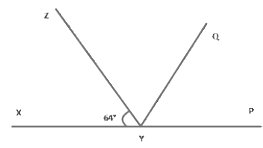 Sol:
Sol:
Here, XP is a straight line
So, ∠XYZ +∠ZYP = 180°
substituting the value of ∠XYZ = 64° we get,
64° +∠ZYP = 180°
∴ ∠ZYP = 116°
From the diagram, we also know that ∠ZYP = ∠ZYQ + ∠QYP
Now, as YQ bisects ∠ZYP,
∠ZYQ = ∠QYP
Or, ∠ZYP = 2∠ZYQ
∴ ∠ZYQ = ∠QYP = 58°
Again, ∠XYQ = ∠XYZ + ∠ZYQ
By substituting the value of ∠XYZ = 64° and ∠ZYQ = 58° we get.
∠XYQ = 64° + 58°
Or, ∠XYQ = 122°
Now, reflex ∠QYP = 180° + ∠XYQ
We computed that the value of ∠XYQ = 122°. So,
∠QYP = 180° + 122°
∴ ∠QYP = 302°
Q8: In the Figure, if PQ || ST, ∠PQR = 110° and ∠RST = 130°, find ∠QRS.
[Hint: Draw a line parallel to ST through point R.]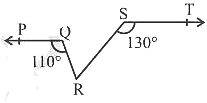 Sol: First, construct a line XY parallel to PQ.
Sol: First, construct a line XY parallel to PQ.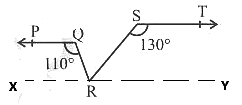 As we know, the angles on the same side of the transversal are equal to 180°.So, ∠PQR + ∠QRX = 180°
As we know, the angles on the same side of the transversal are equal to 180°.So, ∠PQR + ∠QRX = 180°
Or,∠QRX = 180° – 110°
∴ ∠QRX = 70°
Similarly,
∠RST + ∠SRY = 180°
Or, ∠SRY = 180° – 130°
∴ ∠SRY = 50°
Now, for the linear pairs on the line XY-
∠QRX + ∠QRS + ∠SRY = 180°
Substituting their respective values we get,
∠QRS = 180° – 70° – 50°
Or, ∠QRS = 60°
Q9: In Fig. 6.40, ∠X = 62°, ∠XYZ = 54°. If YO and ZO are the bisectors of ∠XYZ and ∠XZY respectively of Δ XYZ, find ∠OZY and ∠YOZ. Sol: As we know, the sum of the interior angles of the triangle is 180°.
Sol: As we know, the sum of the interior angles of the triangle is 180°.
So, ∠X +∠XYZ + ∠XZY = 180°
substituting the values as given in the question we get,
62° + 54° + ∠XZY = 180°
Or, ∠XZY = 64°
Now, As we know, ZO is the bisector so,
∠OZY = ½ ∠XZY
∴ ∠OZY = 32°
Similarly, YO is a bisector and so,
∠OYZ = ½ ∠XYZ
Or, ∠OYZ = 27° (As ∠XYZ = 54°)
Now, as the sum of the interior angles of the triangle,
∠OZY +∠OYZ + ∠O = 180°
Substituting their respective values we get,
∠O = 180° – 32° – 27°
Or, ∠O = 121°
|
44 videos|412 docs|54 tests
|

|
Explore Courses for Class 9 exam
|

|

















